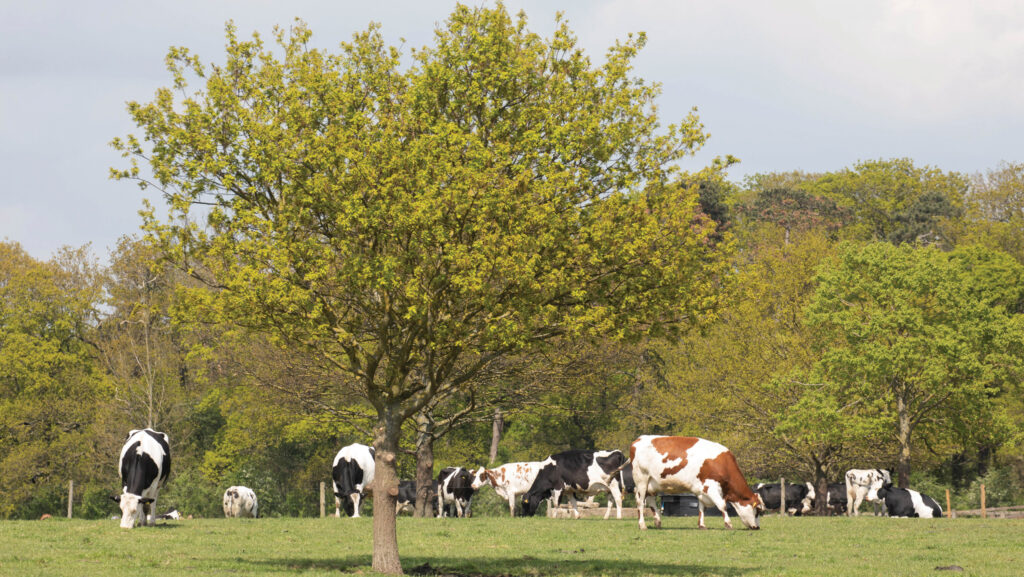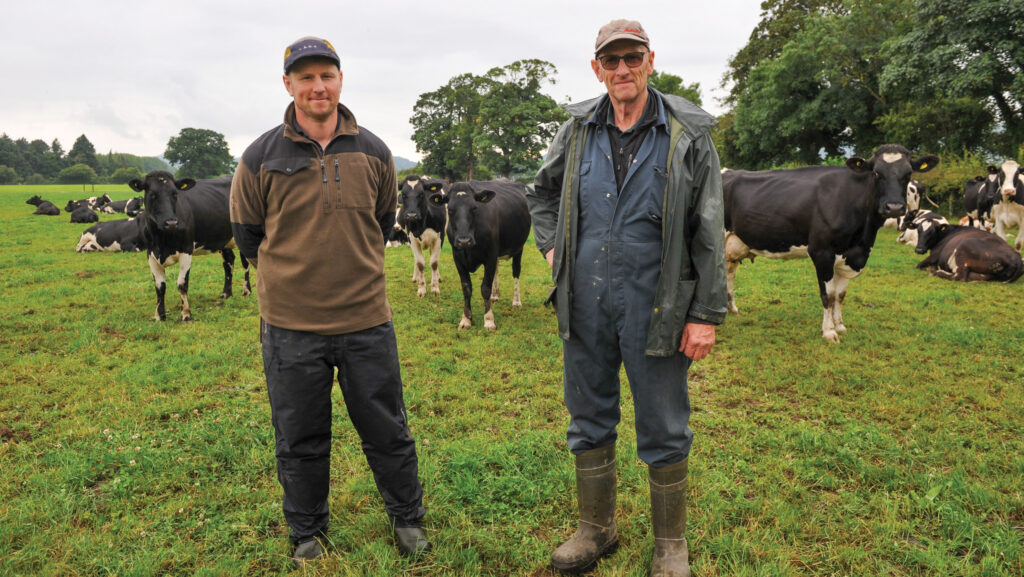Why planting more trees could protect milk yields
 © Tim Scrivener
© Tim Scrivener New data show the impact on dairy cows of heat stress induced by an absence of shade during hot weather.
It resulted in a milk yield loss of 117.3kg a cow, estimated over an 87-day period, compared with just 9.1kg a cow in animals sheltered from the sun.
The Evans family produce milk from a herd of 470 Holstein/Norwegian Red/Friesian crossbreds at Kilford, near Denbigh.
They have been working with Farming Connect to investigate the value of trees and hedges as shade and shelter for their stock.
See also: How silvopasture can help with heat stress
From February to late September/early October, their herd grazes rotationally on the 330ha (815-acre) holding.
The effects of rising temperatures on dairy cows are being monitored as part of the Farming Connect Our Farms study.
The first set of data points to a significant loss in milk production where the herd has been exposed to full sun on the hottest days of the summer.
Intense heat
Real-time insights into cow drinking, rumination, activity, and internal heat stress levels were achieved from a combination of SmaXtec rumen boluses and sensors measuring temperature and temperature humidity index (THI).
(THI is a metric combining air temperature and humidity levels to indicate the level of heat stress on cattle.)
The research focused on the 87 days from 5 May to 27 July 2025 when there were frequent periods of intense heat.
On one day, 12 July, the temperature sensor showed that in areas where there was no shelter on the grazing platform, the radiant heat (heat from the sunshine) was 41.6C.
This is the heat of which a black-coated animal in particular will feel the effects when stood in full sun with no shade.
The THI in these areas was 32.1C. In areas shaded by trees, the radiant heat was significantly lower, at 29.8C, and the THI reading was 30.2C.
Measurements were also taken in the farm’s cubicle buildings where the radiant heat temperature on 12 July was 31.3C.

Dafydd and Dilwyn Evans © Debbie James
Likely losses
Vet and consultant Tom Chamberlain, who analysed these data, calculated a possible milk yield loss a cow nearly 13 times greater if the herd was at grass under full sun for those 87 days than if it was able to access full outdoor shade.
The calculation was based on a cow producing an average daily milk yield of 30kg.
Based on that production level, the potential milk losses at the temperatures recorded at Kilford showed a range of 0-2 litres a cow a day from moderate heat stress.
This loss rose to 2-4 litres in a cow experiencing high heat stress, and 4-6 litres in those with severe heat stress.
Gwenan Evans, dairy sector officer at Farming Connect, who is overseeing the project, says the data show the challenges heat stress presents to the dairy industry.
“Despite the potential of heat stress to significantly impact cow welfare and profitability, it’s a topic that has been surprisingly under-researched in Wales,” she says.
“With summer temperatures now frequently climbing above 21C – a threshold for heat stress – and many farms in Wales having open grazing systems, we suspect this could be a major hidden issue.”
Not only does heat stress decrease milk yield, it also results in reduced lying times, which has a detrimental impact on cow foot health, resulting in increased lameness and poorer fertility.
Nature-based solution
Integrating trees into livestock grazing systems offers an answer. Farming Connect woodland specialist Geraint Jones describes it as a “powerful, nature-based solution that significantly reduces heat stress in cattle”.
“As our climate changes, strategic tree establishment becomes a critical tool for farmers,” he says.
Trees create essential microclimates by providing shade and increasing humidity, which directly benefits livestock by lowering air temperature and reducing heat stress.
This combination is highly effective in mitigating the impact of extreme heat on cattle, Geraint adds.
“Providing an environment where cows are as comfortable as possible is paramount, and trees can be a key factor in creating this environment.
“Over the next few years, establishing trees will be crucial for building farm resilience, safeguarding animal welfare, and providing long-term economic benefits in the face of a warming climate.”
Shade and humidity
Trees release water vapour through transpiration, increasing local humidity. While people often associate high humidity with feeling hotter, Geraint says it is more complex for animals.
“When this humid air is blown over a hot animal, the animal’s sweat or panting evaporates more effectively due to the cooler, more humid air, which helps cool them down.
“Shade provided by trees is the most significant factor, but the increased humidity from transpiration is a contributing factor to the cooler microclimate that helps livestock cope with heat stress.”
Next steps
At Kilford, the Our Farms project work will now identify opportunities for integrating trees into the farm’s grazing paddocks, while monitoring temperatures and their impact on cows will continue until the end of September.
The goal is to develop an agroforestry system that maintains or improves grass productivity while enhancing ecosystem services, says Geraint, ultimately delivering both environmental and economic advantages to the farm.
He points out that the research at Kilford emphasises the critical role trees play in enhancing the resilience of farms to climate change.
“As temperatures continue to rise, the importance of tree cover for livestock welfare will only grow,” he adds.
Integrating trees and hedges into livestock systems
Integrating trees into grazing systems provides livestock with significant shade and a natural shield against solar radiation.
The focus should be on planting trees on the grazing platform, advises Geraint Jones of Farming Connect – although utilising winter housing to provide shade when it is needed is a good practical option, too.
1. Select trees that offer the best potential for shade
Trees with wide canopies and dense foliage offer the most effective solution for providing substantial shade, thereby maximising their role in reducing the risk of heat stress to livestock.
Planting a variety of tree species within a hedgerow or a shelterbelt, with different flowering and fruiting times, for example, supports a greater level of biodiversity.
2. Plant trees where they have the greatest impact
The level of heat stress mitigation trees offer is influenced by the local microclimate specific to every farm. Strategic tree planting in open, sun-exposed areas will inevitably yield the greatest benefits.
3. Value existing trees – and plant more
Existing tree cover provides cattle and sheep with some protection against the adverse impacts of a changing climate.
However, the amount of shade provided by trees already established on a farm can often be limited, especially in systems where livestock numbers have substantially increased in recent years, Geraint says.
As well as conserving those trees, measures to enhance cover should therefore be a priority. “Tree planting is a sound investment in the long-term health and productivity of livestock,’’ says Geraint.
“Approaching it with a long-term vision is essential to ensure it provides shelter and shade for animals for future decades.”
Farming Connect is running a series of farm walks in September, including at Kilford, where farmers will hear more about the projects that are under way on sites in the Our Farms network.
Details can be found on the Farming Connect website.
